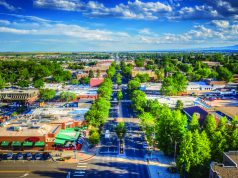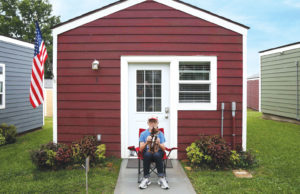
The saying goes that if you give a man a fish he’ll eat for a day, but teach a man to fish and he’ll eat for life.
But what if said man already knows how to fish but nothing’s biting? Or maybe the man doesn’t have fishing gear. Sometimes giving people metaphorical fish is exactly the help they need.
Soon, 200 Boulder residents will receive no-strings-attached monthly payments of $500 for two years through a guaranteed income pilot project called Elevate Boulder that the City hopes will improve financial stability, reduce food insecurity, and boost mental wellbeing for low-income residents. The pilot is just one of several dozen projects across the country challenging traditional American notions of what public benefit programs should look like.
Guaranteed income differs from programs like Temporary Assistance for Needy Families (TANF) and Supplemental Nutrition Assistance Program (SNAP), which often require cumbersome reporting and have myriad qualifying requirements that experts say can become barriers to those who need the benefits most. For those who do qualify for these programs, making even a little bit more money can lead to disqualification, a phenomenon known as the “welfare cliff.”
Elizabeth Crowe, Boulder’s deputy director of Housing and Human Services, says that a general unfamiliarity with the burdensome conditions of programs like SNAP and TANF can lead those who don’t need assistance to wonder why these supplements aren’t enough for struggling families. Guaranteed income programs like Boulder’s provide an extra layer of support without all the hoop-jumping.
“[Guaranteed income] is a potential solution when you add it to other benefits … that enables people to get more money in their pockets to take care of the needs of themselves and their families, and the dignity that comes with having that choice,” she says.
To qualify for Boulder’s pilot program, participants must be 18 years or older, reside within city limits, have been impacted by COVID and make between 30%-60% of Boulder’s area median income — between $27,900 and $55,800 for a household of one and increasing by household size. Participants must be Boulder residents for the duration of the program, but there’s no continued income reporting, meaning participants who start making more or less money after the program’s start will still receive payments.
Crowe says the City expects to receive thousands of applications. Participants will be selected through a randomized lottery and applications will open later this fall with payments starting in January 2024.
The project is primarily funded by $3 million in federal COVID-relief funds and, more recently, a $70,000 grant from the Community Foundation of Boulder County, which also launched a fund that community members can contribute to.
Indira Kumari — a medical assistant, Nepali immigrant, and low-income Boulder resident who is part of the task force that helped build the pilot — says receiving $500 a month could prevent her from having to make difficult choices about what she and her family need most.
“My kids have got, even now, quite a bit of medical needs,” Kumari says. “Even with two incomes I cannot [meet their needs.] In order to [provide for them], I had to kind of skip my meals. … Had I had some supplemental support, I could have been better off [attending to] those kinds of medical needs.”
Crowe says that in addition to providing these types of immediate and tangible benefits to participants, she also hopes the program will help City processes become more equitable and challenge assumptions some community members might have about one another.
Across the country
Direct cash assistance is hardly a new concept — it’s been studied for decades, with many investigations showing positive outcomes. But in recent years, it’s taken on a new prominence in the public eye.
In 2019, a pilot program in Stockton, California, was one of the first guaranteed income projects to launch in the U.S. Similar to Boulder’s pilot, the Stockton project, known as SEED, provided $500 to 125 residents who lived in a neighborhood with a median income at or below the city’s median household income for two years.
The idea of no-strings-attached cash payments also gained traction when 2020 presidential candidate Andrew Yang ran on the platform of unconditional payments of $1,000 to all Americans, a concept called Universal Basic Income (UBI), which is often used interchangeably with guaranteed income but differs in that it provides cash to all citizens rather than a target population.
Stimulus checks during COVID, the Earned Income Tax Credit and the Child Tax Credit, are also examples of cash assistance programs at the federal level.
Since the Stockton pilot, more than three dozen guaranteed income pilots have launched across the country from Birmingham, Alabama, to Newark, New Jersey, to San Diego, California. Preliminary results from a pilot in Denver offering guaranteed income to people experiencing homelessness show that participants used the money to meet immediate basic needs and plan for the future, with positive outcomes for their mental health and children or family members.
Stephen Nuñez, who was the lead researcher on guaranteed income at the Jain Family Institute and has more than a decade of experience in program evaluation, says the “tidal wave” of guaranteed income pilots will be most valuable in answering structural questions about benefits and generating policy momentum, as decades of research has already born out the benefits for participants.
“The general thrust of it is: Are [guaranteed income recipients] gonna quit their jobs? No. Are they gonna do drugs? No. Does it make them better off? Yes,” Nuñez says. “We already know all that. And we don’t need more research to do that … it’s really more about an opportunity to share with the general public what researchers already know, but then also to do that coordination to make sure that it’s not just a bunch of pilots.”
‘What will they spend it on?’
While critics of guaranteed income programs argue that no-strings-attached cash assistance disincentivizes recipients from working or that participants will use the funds “irresponsibly,” data suggests otherwise.
The SEED pilot, for example, found that participants were significantly more likely to find full-time employment compared to the control group. It also revealed that participants were better able to cover unexpected expenses, improved emotional and mental health, and created new opportunities for “self determination, choice, goal setting, and risk-taking.”
The SEED pilot showed that the greatest share of the money was spent on basic needs like food, clothes, home goods, auto costs and utilities, while less than 1% was spent on alcohol or tobacco.
Kumari says that if she is part of Boulder’s pilot, she would likely use the money for medical bills, housing and food, as well as for entertainment, like taking her family to the movies or out to dinner — something she says she hasn’t been able to do in ages.
Nicole Borrelli, another task force member and the director of housing and economic justice at Boulder-based domestic violence support nonprofit Safehouse Progressive Alliance for Nonviolence, says she’s experienced what it’s like to be in survival mode firsthand.
“You’re so focused on, ‘I need to get a place [to live]. I need to get food on the table. I need to find three jobs so I can pay for it,’” she says. “Having a little bit of wiggle room, that opportunity to take a breath, to take your kid out to a movie, it may not seem like a big deal to a lot of people, but it’s huge. You need that to function as a parent. If you don’t take care of yourself, you can’t take care of your kids.”
However, Jeffrey Zax, a CU Boulder professor of economics who specializes in labor economics, says guaranteed income programs have the potential for disincentivizing work.
“When you help people, you diminish, at least slightly, their incentive to help themselves,” he says.
Still, he says it’s unlikely to occur on a large scale.
“There aren’t that many ‘welfare queens’… that really doesn’t happen very much and it’s not going to happen with this program,” Zax says. “$6,000 [annually] is not a lot to live on, especially in Boulder.”
Nuñez says that in addition to the administrative burden associated with other safety net programs, various requirements can also be “paternalistic and insulting,” and “suggest a distrust” of those receiving benefits.
Nuñez points out the racism and classism baked into that distrust, some of which dates back to Regan-era “welfare queen” narratives that have led to benefits being “even more conditional and even more restrictive.”
Crowe says there’s a pervasive belief in American society that “if you don’t have enough means to support your family, you must have done something wrong.”
“Oftentimes that is extended to or sourced from a belief that people who are Black or brown inherently don’t have the ability to make good financial decisions or you wouldn’t be in that position,” Crowe says. “As opposed to … government systems that intentionally prevented Black and brown folks from being able to acquire and maintain wealth.”
Nothing about us without us
In building the pilot, nine community members who have experienced being low-income in Boulder or work with low-income populations served on a task force to weigh in on program design and implementation. Part of that, Crowe says, was working to make the application process “dignified.”
Kumari says she wanted to make sure that other members of the Nepali community could access the application regardless of language, address or immigration status.
“I have gone through that and I did not want the same feeling of invisibility towards my other community folks,” she says.
The City is also contracting five constituent-led organizations to help community members with the application process. The organizations serve populations that are disproportionately impacted by income disparities including Latinx, Black, Nepali, LGBTQ and disabled community members.
Crowe says task force members helped to make decisions about various trade-offs, like how long the program would run, how many people could participate and how much money could be provided based on the project’s budget.
“Having their thoughts, their hearts, their expertise, their wisdom, and their collaborative spirit to really talk to and listen to each other was really critical,” Crowe says.
Scaling Up
When it comes to making guaranteed income programs a more permanent part of the social safety net, Nuñez says locally based programs could prove difficult.
“It wouldn’t make sense for every city in the country to have its own little cash assistance program,” he says. “Cities don’t usually have the infrastructure to implement it and they don’t necessarily have control of the purse strings.”
For Zax, the CU Boulder economist, the biggest strain of scaling up a local project would be on the City budget.
“The bigger you make [the program], the more attractive it is for people to take advantage of it,” he says. “200 people, the odds that anybody who’s eligible will get it are quite small. But if those odds go up, then one of the problems the City’s gonna run into is that people will move here in order to take advantage of it.”
Nuñez says that on the large scale, it makes sense for guaranteed income programs to be administered at the state and federal levels. He also says that in order to remove some of the administrative burden, programs could pay all individuals, then tax the money back based on income.
And while there’s not a huge body of research, Nuñez says guaranteed income programs have the potential to benefit the economy writ large, citing costs of child poverty, the criminal justice system and homelessness that direct cash assistance could mitigate. Still, the benefits of guaranteed income have limits, Nuñez says, and it’s important to think about how the programs will interact with other systems.
“For those who think that guaranteed income is the solution to everything, I’ll just say, if there isn’t a well functioning market, it’s not going to solve any problems,” he says. “Giving people a bunch of money and just saying, ‘Here you go, now you don’t have to worry about health care,’ is not the solution. That is not a well functioning market. … It is not a replacement for health insurance, for a strong unemployment insurance system.”
Nuñez hopes the pilots and the stories that come out of them will expose deficiencies in the social safety net and help the general public and policymakers change how they think about poverty and its solutions.
“The truth of the matter is, money’s gonna run out,” he says. “The pilots are gonna end in two or three years. And then the question is: What do we have to show for it? We want to be able to say, ‘We took this opportunity to connect different groups and push for legislative change.’”
For Crowe, the pilot is an opportunity for the community to lean into empathy.
“This is a very unique opportunity to really try to address problems of economic inequity at its core by raising the level of income people have, and doing it in a way that leans further into trust and dignity,” Crowe says. “We really encourage others to be curious and be willing to learn some new things and hopefully we’ll have a project that is well worthy of continuation post-pilot.”
ON SCREEN: It’s Basic documentary screening and community conversation. Tuesday, Oct. 10, 6 – 8 p.m. eTown Hall, 1535 Spruce St., Boulder. RSVP or learn more at bit.ly/ItsBasicDoc














